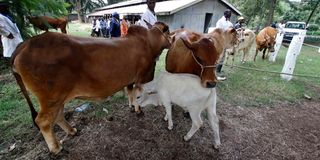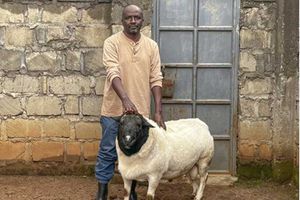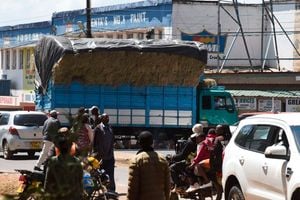
Beef cattle of the Boran breed from ADC Mutara in Laikipia parade for the judges at the Nakuru ASK Showground on July 5, 2022.
At least eight million Kenyans, mainly in the arid and semi-arid counties depend on beef cattle for their livelihood.
The predominant production system is pastoralism, where animals move in search of pasture.
In a few counties like Laikipia and Taita Taveta ranching is common. Increasingly, you will find mini feedlots, where animals are finished over an intensive three to four-month period.
Some farmers in my county are agro-pastoralists. I am one of them. You can call us part time pastoralists.
We keep mixed herds, some for milk and some for beef. We feed animals on crop residue after harvest, but also grow limited fodder.
I once featured in Forbes magazine for attracting a private equity investment into a meat business. With a slaughterhouse in Rumuruti, we were processing and packing high quality, grass-fed Laikipia beef.
As governor, I promoted a policy on feedlots both as a response to climate change and a way to increase productivity of the livestock sector. I had some success.
The county attracted one medium sized feedlot with 5,000 head of cattle, and dozens of micro feedlots. Encouraged, and with the assistance of the World Bank, my government prepared a business plan for a large scale vertically integrated beef business.
Based on a large-scale feedlot as the anchor, the business would be linked with breeding operators who would supply weaner calves, buy fodder from farmers specifically contracted, and have large meat processing. We took Zambeef Products PLC as an example, and wanted to invest US$100 million, so that the business of have sufficient scale to make a difference.
But in the zero-sum game that is Kenyan politics, succeeding administrations often throw away whatever ideas they find on the table. The Laikipia Beef SPV was thus put on ice once I was out of office. That is a shame because the Drive Program that was to provide some funding to help crowd-in private sector into the investment went ahead.
Drive is forward-looking program which covers four countries in the Horn of Africa. It has fodder insurance to support pastoralists with breeding herds during periods of poor pasture.
The component is progressing quite well. Not all was lost. The Kenya Development Corporation is, as was planned, using the investment funds from the program to finance private sector projects in the value chain.
Recently, there has been talk of an even bigger program, part of the bottom-up economic transformation agenda.
The fine details of the proposed program design remain scanty. But the elements remain – anchor enterprises supporting hundreds of SME feedlots, who in turn are off-taking weaner calves from tens of thousands of pastoralists.
This is great, because at Sh190.5 billion marketed value in 2023, livestock is a key economic sector. This is farm gate value. The value-added potential is huge. Leather alone contributes an estimated 1.5% to the gross domestic product. There are 2,300 butcheries in Nairobi. Yet this sector has received lukewarm efforts from previous governments. Will board-based succeed where earlier governments have failed?
One Kibaki era idea was creating disease free zones, to enable us regain international export markets. This hit a snag because lands previously used as holding grounds, stock routes, and pasture banks had been put to alternative uses.
Moi era politicians and brokers never liked to see any piece of land looking empty, as grazing fields do. So, the Livestock Marketing Division lost hundreds of thousands of acres to settlement areas.
The stock routes, pasture banks, holding grounds and outspans were planned in a sequence such that as animals walked towards terminal markets, they received veterinary care, cleaning them from Rift Valley Fever and other diseases.
In counties like Laikipia the stock routes have been neglected and interfered with, forcing pastoralists to use ordinary roads when moving livestock.
The Jubilee administration pursued disease-free idea, with the VET Department developing protocols to certify disease free compartments. If the whole country could not achieve disease free status, perhaps individual farms or ranches could.
A number of Laikipia ranches did in fact attain the status. One was thus able to export boran breed embryos.
There are plenty of institutions. Counties have Livestock departments. The National government has a State Department as well as the Veterinary Department at Kabete.
Kenya is also host to the African Union – Interafrican Bureau for Animal Resources (AU-IBAR) and the International Livestock Research Institute (ILRI). Both serve the continent and beyond. But even with this institutional architecture, the sector has not achieved potential.
Annually, we slaughter 2 million head of cattle and 10 million sheep and goats. This level is down from the pre-Covid peaks of 2.6 million and 12 million for cattle, and sheep and goats respectively. The farm gate value of marketed livestock is higher than tea, and ten times more than coffee. Kenya remains a net importer of livestock.
One significant failure has been the poor implementation of the Branding of Stock Act Enacted in 1907, the act has been amended several times over the last century.
This crucial law creates a property registry of livestock. Properly used, this registry will unlock the full potential of livestock as valuable assets.
All business is based on property rights. An asset qualifies as such because its ownership is defined. An iron ore deposit in Laikipia is not an asset, and cannot generate cashflows unless rights over it have been recognized and assigned to someone.
We can finance and insure a pick-up truck because it has a logbook, which proves ownership. What is the logbook equivalent for livestock?
@NdirituMuriithi, an economist is partner at Ecocapp Capital










